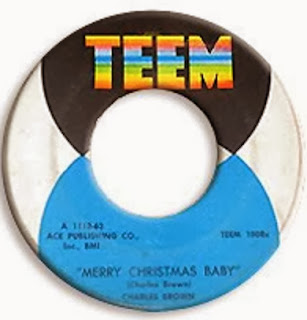Pictured above are arranger Jack Nitzsche, Darlene Love, and producer Phil Spector.
Christmas (Baby Please Come Home) was first recorded, and became available for a short time, 50 years ago as part of the "A Christmas Gift for You from Philles Records" album. Although it is a well-known song today, it did not receive very much recognition for many years. A few other songs from that LP did enjoy some popularity on Top 40 radio stations in the 60's, but that song did not.
For one thing, the LP was released the day of the JFK assassination and that Christmas season was a little subdued (despite The Beatles breaking out in the USA on east coast stations with I Want To Hold Your Hand just before Christmas).
Another reason is the album went out-of-print very quickly, making the song unavailable. Good copies of the LP were much sought after by collectors and there was no ebay, no internet, no Goldmine, and very few used record stores in those days. I recall finally finding one for myself in the late 60's at Skippy White's in Boston and I suspect it was an "unofficial re-release".
Around 1972 The Beatles re-released the LP, officially, on their Apple label, but with a different name and jacket, and that too went out-of-print fairly quickly.
Although it was a well-known Christmas classic to music enthusiasts of that era, I don't think it really got popular with the general public until the 1980's. Better late than never.
Let's take a look at the song and recording.
It was written by the great wife-husband (at that time) team of Ellie Greenwich and Jeff Barry.
That's them in the middle between fellow "Brill Building" writers Neil Diamond and Bert Burns (who was also a great producer and wearer of really bad rugs).
Greenwich and Barry had intended the song for Ronnie Bennett of the Ronettes, but Spector didn't feel she could give it the emotional blast it required, but there was someone else in the studio who could: Darlene Love of The Blossoms, who at that time were also posing as The Crystals on the west coast.
Some of the cream of the LA based studio musicians collectively known as the Wrecking Crew played on the song. Leon Russell on piano, Hal Blaine on drums, Steve Douglas honking that great baritone sax. Helping to create the Spector Wall of Sound were heavy-weight guitarists Barney Kessell, Tommy Tedesco and Bill Pitman! Also listed on guitar is Nino Tempo....although he his much better known for his sax playing...and sometimes singing.....and for having a hot sister. And who played the jingle bells, you ask? Well, I wasn't going to mention it, but since you asked, it was Sonny Bono. Backing up Darlene were all the ladies of The Ronettes and Crystals (east coast and west coast) plus a 17 year old young lady who went by the name "Cher".
Even though it took many years for the song to become a Christmas pop classic, Spector knew a good thing when he heard it and he knew right there in the Fall of '63 that it was a great song, so as long as everyone was already in the house he decided to record a non-Christmas version of the song too.
The song was never released.
The Ronettes, The Crystals, The Blossoms all sort of faded away by the late 60's. Things change. Around that time Spector started battling his own personal problems. Darlene never completely left the business. She raised a family and worked recording sessions doing backing vocals where she met and maintained contact with many people in the business. In the early 80's she began performing again a little bit around LA. One of her fans, Steve Van Zandt, aka Miami Steve of Bruce Springsteen's E Street Band, talked her into going to New York and doing some performances there which led to some work in stage musicals and film scores. In the mid-80's New York showbiz scenester Paul Shaffer, leading the house band on Late Night with David Letterman, thought it would be great to get Darlene on the show to do this song each year on the last show before Christmas and she's been doing it ever since. Each year the production seems to get bigger and bigger. They even bring in the baritone sax used by the late Steve Douglas on the original recording. There are many clips of these performances available on youtube. No doubt this has been a huge boost to the popularity of the song.
Also, in 1987 while doing a sound check in Glasgow, the tapes were rolling and caught a very decent performance of the song by U2. They later embellished the tape by having Darlene dub backing vocals onto it and that recording received a lot of airplay 20 - 25 years ago and that also helped increase the popularity of the song.
In 1992, Steve Van Zandt wrote a Christmas song for Darlene called All Alone At Christmas and they were joined in the studio by other members of the E Street Band to record it.
I believe Darlene is making her annual Christmas appearance on Letterman this Friday night.


















































